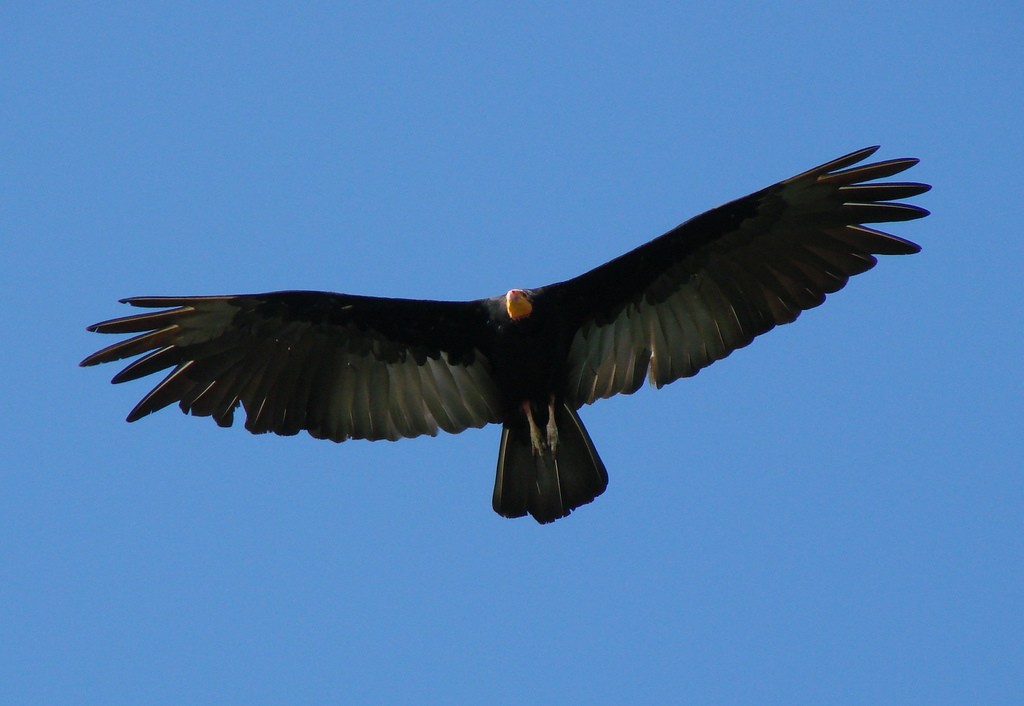Greater Yellow-headed Vulture
A species of Turkey and Yellow-headed Vultures, Also known as Forest Vulture Scientific name : Cathartes melambrotus Genus : Turkey and Yellow-headed Vultures
Greater Yellow-headed Vulture, A species of Turkey and Yellow-headed Vultures
Also known as:
Forest Vulture
Botanical name: Cathartes melambrotus
Genus: Turkey and Yellow-headed Vultures
Content
Description General Info
Description
The greater yellow-headed vulture is 64–75 centimetres (25–30 in) in length, with a wingspan of 166–178 centimetres (65–70 in), a tail length of 25–29 centimetres (9.8–11.4 in) and a weight averaging 1.65 kilograms (3.6 lb). Its plumage is black with a green or purple sheen. The throat and the sides of the head are featherless. The skin on the head ranges in color from deep yellow to pale orange with a blue crown. The nape and the area near the nostrils are pale pinkish. The undersides of the wings are black, while the flight feathers are a lighter shade. The quills of the eleven primary feathers appear to be white when seen from above. The tail is rounded and long for a vulture, extending to or slightly beyond the tip of the closed wing. The sexes are outwardly similar. The head is dull greyish in juveniles, which otherwise resemble adults. The irises of its eyes are red, its feet are black, and its beak is flesh-colored. The eye has a single incomplete row of eyelashes on the upper lid and two rows on the lower lid. Its beak is thick, rounded, and hooked at the tip. Because of its habit of urohidrosis, the scaly portions of its legs are often streaked white with uric acid. The front toes are long with small webs at their bases and are not adapted to grasping. The opening of the nostril is longitudinal and set in a soft cere, and the nostril lack a septum. Like all New World vultures, the greater yellow-headed vulture lacks a syrinx, and is therefore unable to make any sound other than grunts or a low hiss. It differs in appearance from the similar lesser yellow-headed vulture in several ways. It is larger than the lesser yellow-headed vulture, with a longer, broader tail. The plumage is a dark, glossy black in contrast to the lesser yellow-headed vulture's browner plumage. Its legs are darker in color and its head is more yellow and less orange/pink than that of the lesser yellow-headed vulture. Its wings are broader and its flight is also steadier. Unlike the other members of the genus Cathartes, the greater yellow-headed vulture has relatively dark inner primaries, which contrast slightly with the paler secondaries and outer primaries. The greater yellow-headed vulture prefers to live in forests while the lesser yellow-headed vulture prefers to inhabit savannas, and it is more heavily built than the lesser yellow-headed vulture. The greater yellow-headed vulture is also somewhat larger than the turkey vulture. It can be distinguished from that species only at relatively close range by the differing head coloration. The underwing coloration is similar to the turkey vulture but the greater yellow-headed usually has a faint but broad and dark band vertically down the middle of the wings. 
Size
81 cm
Nest Placement
Ground
Feeding Habits
Greater Yellow-headed Vulture is a scavenger, primarily consuming carrion, particularly favoring fresh meat. Although incapable of tearing tough hides, greater Yellow-headed Vulture exploits carcasses opened by stronger birds. Greater Yellow-headed Vulture uniquely locates food via ethyl mercaptan scent, combining keen eyesight and an advanced olfactory system. Water drinking and carcass abandonment after decay are notable behaviors.
Habitat
The habitat of greater Yellow-headed Vulture is primarily the tropical moist lowland forests within the Amazon Basin, with a strong preference for undisturbed primary forests rich in tree cover. These regions provide the bird with abundant nesting options and protection. Adverse to higher altitudes and human-altered landscapes, greater Yellow-headed Vulture primarily avoids non-forest habitats, differentiating its ecological niche from relatives who opt for more open spaces.
Dite type
Scavenger
General Info
Feeding Habits
Bird food type
Behavior
The greater yellow-headed vulture roosts on high, exposed dead trees to observe surrounding terrain. When flying, it travels in pairs or alone and is rarely found in groups. Flight is heavy and steady. It flies with its wings held flat or very slightly above horizontal, in what is called the dihedral position. The flight of the greater yellow-headed is an example of static soaring flight, which uses thermals to maintain altitude without the need to flap its wings. The greater yellow-headed vulture also has the unusual habit of urohidrosis, in which it urinates or defecates on its legs to cool them evaporatively. This behavior is exhibited by storks and New World vultures. 
Distribution Area
The greater yellow-headed vulture is found in the Amazon Basin of tropical South America; specifically in south-eastern Colombia, southern and eastern Venezuela, Guyana, French Guiana, Suriname, northern and western Brazil, northern Bolivia, eastern Peru and eastern Ecuador. It is not found in the Andes, in the lowlands west or north of the Andes, in the relatively open regions of northern South America, eastern South America, or in the southern subtropical regions. It has a large range, with an estimated global extent of occurrence of 6,700,000 square kilometers (2,586,884.5 sq mi). Its natural habitat is tropical moist lowland forests. It is not generally found in high-altitude regions. It is common in heavily forested regions. It may wander over grasslands, but rarely strays far from forested areas, which provide shelter and nesting areas. 
Species Status
The greater yellow-headed vulture is listed as a species of Least Concern by the World Conservation Union (IUCN). It has an estimated global range of 6,700,000 square kilometers (2,600,000 sq mi) and a population of between 100,000 and 1,000,000 individuals. There is evidence that suggests a decline in the species' population, but it is not significant enough to warrant an upgrade in conservation status. 
